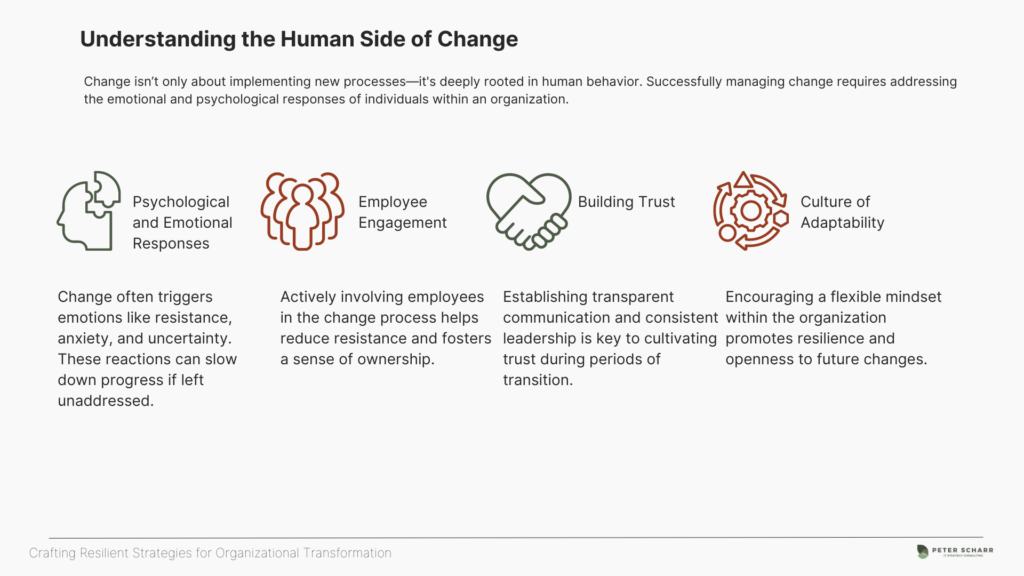Understanding the Nature of Change – The Foundation of Effective Transformation
In today’s fast-paced world, change is not just a possibility—it’s a certainty. Organizations that resist or fail to anticipate change often find themselves falling behind. But what exactly is *change management*? At its core, it’s the process of guiding an organization through transitions—from adopting new technologies to restructuring teams—to ensure that these shifts are as smooth and successful as possible.
As we dive deeper into the topic, it’s essential to understand why change management is crucial. Without a planned approach, even minor adjustments can lead to confusion, resistance, or outright failure. A well-developed change management strategy doesn’t just help organizations survive; it helps them thrive in an evolving landscape. But to craft these strategies, we first need to recognize the different types of change and the specific challenges each presents.
Types of Organizational Change
There’s no one-size-fits-all when it comes to change. Organizations face different types of change, each requiring a unique approach. Broadly, we can categorize them into three distinct types:
- Incremental Change: This is the most common form of change and happens gradually, often through small, continuous improvements. Think of it as fine-tuning processes or making periodic updates. While seemingly minor, incremental change can still face resistance if not handled properly. A strong example of this is when companies like Toyota continuously improve their manufacturing processes through small, consistent changes.
- Transformational Change: Transformational change involves a significant overhaul of an organization’s processes, structure, or culture. This type of change is often driven by a need to adapt to new market conditions or internal challenges. For example, when Nokia shifted from manufacturing rubber products to becoming a leader in telecommunications, it was a classic case of transformational change. Such shifts require comprehensive planning and a clear vision to succeed.
- Disruptive Change: Disruptive change is often unexpected and can shake an organization to its core. It’s typically driven by external factors, such as technological advancements or new competitors. Companies like Netflix or Uber have disrupted entire industries, forcing others to adapt—or risk becoming obsolete. Disruptive technology often accelerates this type of change, creating both threats and opportunities for organizations.
The First Step: Recognizing the Nature of Change
One of the biggest mistakes organizations make is underestimating the type of change they’re facing. Treating transformational or disruptive change as if it were merely incremental can lead to poor decision-making and strategy failures. As we’ll explore further, recognizing the nature of change is the first step in handling it effectively. This awareness informs everything from leadership decisions to communication strategies, and ultimately determines how smoothly the organization adapts.
Understanding the nature of change isn’t just about categorizing it—it’s about knowing how each type impacts your organization in different ways. By recognizing whether you’re dealing with an incremental, transformational, or disruptive shift, you can better prepare your team, minimize resistance, and create a strategy that guides your organization toward success.
The Human Side of Change – Navigating Emotions and Building Trust
As explained before, recognizing the nature of change is critical to crafting a successful transformation strategy. But even the most well-planned strategies can falter if they overlook a crucial element: people. Change management isn’t just about processes, frameworks, or new technologies—it’s about addressing the psychological and emotional responses that change inevitably triggers in individuals. After all, organizations don’t change; the people within them do.

It’s common for employees to experience feelings of resistance, anxiety, or uncertainty when faced with change. These emotions aren’t just hurdles—they’re natural human reactions. If not managed properly, they can create significant barriers to success. However, by understanding these emotional responses and proactively addressing them, leaders can not only reduce friction but also build a culture of adaptability and resilience.
Why People Resist Change
Resistance to change is one of the most familiar challenges organizations face. But why do people resist in the first place? There are a few common reasons:
- Fear of the Unknown: Change often brings uncertainty. When employees don’t know how their role or future will be impacted, it can lead to anxiety. For example, a shift to new technology might raise concerns about job security or the need for new skills.
- Lack of Trust: If employees don’t trust leadership or believe that the change is in their best interest, they’re more likely to resist. This trust deficit can be traced back to poor communication or a history of failed changes.
- Comfort with the Status Quo: People are naturally inclined to stick with what’s familiar. Even if the current system isn’t perfect, it’s predictable. Change, on the other hand, represents disruption to that comfort zone.
Understanding these underlying reasons is crucial for leaders to address resistance in a compassionate and effective way. As a leader, dismissing these concerns can alienate employees, but addressing them head-on can build trust and engagement.
Building Trust and Engaging Employees
So how can organizations mitigate resistance and help employees navigate the emotional landscape of change? It all starts with building trust and fostering engagement. Here are a few key strategies:
- Communicate Transparently: One of the most effective ways to ease anxiety is through clear, consistent communication. Employees need to understand the *why* behind the change. Why is it happening? How will it benefit them in the long run? Sharing the vision and goals behind the change ensures that employees feel included and informed. As highlighted in a Forbes article, transparency builds trust, which is the foundation for any successful transformation.
- Listen and Empathize: Change is a two-way street. While leadership may be driving the transformation, employees are the ones who will live through it. Actively listening to their concerns and empathizing with their fears can go a long way in reducing resistance. It’s important to create spaces where employees feel comfortable voicing their thoughts, whether through surveys, town halls, or smaller team discussions.
- Provide Support and Training: Change often requires new skills or behaviors. Offering the right support, such as training programs or professional development opportunities, helps employees feel more confident about navigating new systems or processes. This not only reduces anxiety but also positions employees to succeed in the new environment. Companies like McKinsey emphasize the importance of equipping employees with the tools and knowledge they need during periods of transformation.
Promoting a Culture of Adaptability
While managing immediate resistance is essential, the broader goal should be to cultivate a culture where adaptability is the norm. Organizations that thrive through change don’t just react to disruptions—they anticipate and embrace them. Building this culture starts with leadership modeling adaptability and openness to new ideas. When leaders show that they are willing to change and grow, it sets the tone for the entire organization.
Additionally, promoting continuous learning and encouraging innovation can help employees see change not as a threat but as an opportunity. Celebrating small wins throughout the change process can also reinforce positive attitudes towards transformation. As we discussed in previous sections, incremental change often happens gradually, and recognizing these moments of progress can foster a sense of achievement and forward momentum.
In conclusion, the human side of change can’t be ignored. By understanding the emotional and psychological responses to change, engaging employees through transparent communication, and promoting a culture of adaptability, organizations can navigate the challenges of transformation more effectively. Ultimately, the success of any change initiative depends not just on the strategy but on the people who carry it out.
Developing a Change Vision and Strategy – Crafting a Roadmap for Success
Once you’ve recognized the nature of the change your organization is facing and addressed the human side of transformation, the next step is to develop a clear vision and strategy. A powerful vision acts as the guiding star for your change initiative, while a well-structured strategy serves as the roadmap to get there. Without these, even the most well-intentioned transformations can quickly lose direction, leaving teams confused and disengaged.
But how do you create a vision that resonates with everyone from C-suite executives to front-line employees? And how do you ensure that your strategy aligns with both short-term needs and long-term goals? Let’s break it down.
Creating a Compelling Vision for Change
The most successful transformations start with a vision that’s not only clear but also compelling. It should answer two key questions: What future are we striving for? and Why is this change necessary? This vision needs to be easy to understand and emotionally resonate with your stakeholders. People are more likely to support a change if they can see how it benefits them and the organization as a whole.
To craft a compelling vision, consider the following steps:
- Involve Key Stakeholders: As we highlighted in the previous section, engaging employees and other stakeholders early in the process helps ensure the vision reflects the needs and concerns of those it will impact most. By including different perspectives, you can create a vision that feels inclusive and achievable.
- Align with Organizational Values: A vision for change should align with your organization’s core values and mission. This makes the shift feel like a natural evolution rather than a sudden, disjointed move. For example, if your company values innovation, your vision should emphasize how the change will foster new opportunities for creativity and growth.
- Keep it Simple and Clear: Avoid overcomplicating your vision with too much jargon or technical details. A clear, concise statement that outlines where the organization is headed and why is far more effective than a lengthy document filled with buzzwords. Employees should be able to understand and explain the vision in simple terms.
A strong example of a company that successfully crafted a compelling change vision is General Electric during their transformation in the 1980s. Under Jack Welch’s leadership, GE’s vision focused on becoming a leaner, more competitive organization, which resonated across all levels of the company and facilitated their shift into a new era.
Building a Practical Strategy
While the vision provides the inspiration, the strategy offers the practical steps to achieve it. A roadmap that clearly outlines the actions needed to move from the current state to the desired future state is essential for keeping the organization on track.
Here’s how to build a solid strategy:
- Set Clear Objectives: Break your vision down into specific, measurable objectives. These objectives should be realistic but ambitious enough to push the organization forward. For instance, if your vision includes adopting new technology, an objective could be, “Train all employees on the new system within six months.”
- Identify Key Milestones: Just as a roadmap has checkpoints, your strategy should include key milestones that signal progress. These can serve as moments to celebrate successes and recalibrate if necessary. As we’ll discuss in future sections, measuring progress regularly is crucial to staying on course.
- Allocate Resources: Any strategy must take into account the resources—time, budget, and personnel—needed to implement the change successfully. Ensure that you have the right people in place and that they are empowered to make decisions and drive the initiative forward.
- Plan for Flexibility: Change is unpredictable. Even the best-laid plans can encounter unexpected challenges. Your strategy should include contingency plans for potential roadblocks, allowing you to remain adaptable as the change unfolds. As we’ll explore later, monitoring progress and being ready to pivot when necessary is key to long-term success.
It’s also important to align your strategy with the long-term goals of the organization. Ensuring that your short-term actions contribute to broader, long-term objectives will prevent the change from feeling disjointed or haphazard. This alignment creates cohesion and helps reinforce the idea that the change is part of a larger, ongoing journey rather than just a one-off initiative.
Ensuring Organizational Alignment
Finally, a successful change strategy requires buy-in from all levels of the organization. As discussed earlier, transparent communication plays a huge role here, but so does ensuring that each department understands how the change aligns with their specific goals and responsibilities. This is where creating a cross-functional team to lead the change initiative can be invaluable. Such teams bring together leaders from various parts of the organization, ensuring alignment and encouraging collaboration.
For example, when <a href=“


